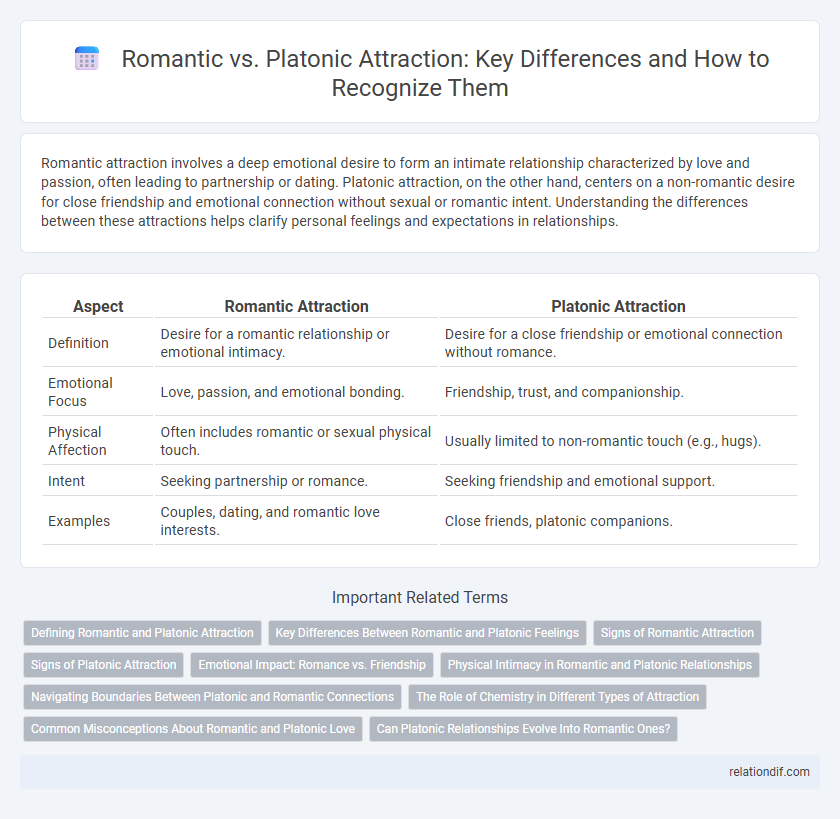Romantic attraction involves a deep emotional desire to form an intimate relationship characterized by love and passion, often leading to partnership or dating. Platonic attraction, on the other hand, centers on a non-romantic desire for close friendship and emotional connection without sexual or romantic intent. Understanding the differences between these attractions helps clarify personal feelings and expectations in relationships.
Table of Comparison
| Aspect | Romantic Attraction | Platonic Attraction |
|---|---|---|
| Definition | Desire for a romantic relationship or emotional intimacy. | Desire for a close friendship or emotional connection without romance. |
| Emotional Focus | Love, passion, and emotional bonding. | Friendship, trust, and companionship. |
| Physical Affection | Often includes romantic or sexual physical touch. | Usually limited to non-romantic touch (e.g., hugs). |
| Intent | Seeking partnership or romance. | Seeking friendship and emotional support. |
| Examples | Couples, dating, and romantic love interests. | Close friends, platonic companions. |
Defining Romantic and Platonic Attraction
Romantic attraction involves the desire for an emotional and intimate connection often characterized by affection, passion, and long-term commitment, while platonic attraction centers on a deep friendship without romantic or sexual intent. Defining romantic attraction includes feelings of love, longing, and the wish to form a partnership, contrasting with platonic attraction's emphasis on trust, companionship, and emotional support. Understanding these distinctions helps clarify relationship dynamics and personal boundaries in social interactions.
Key Differences Between Romantic and Platonic Feelings
Romantic attraction involves a desire for intimacy, emotional closeness, and often physical connection with a partner, while platonic attraction centers on deep friendship and emotional bonding without sexual intent. Romantic feelings typically include passion and a longing for exclusivity, whereas platonic feelings emphasize trust, support, and companionship without romantic expectations. Understanding these key differences helps clarify relationship dynamics and personal boundaries in social interactions.
Signs of Romantic Attraction
Signs of romantic attraction often include a desire for physical closeness, increased heart rate when near the person, and frequent thoughts about shared future experiences. Individuals may demonstrate heightened attention to appearance and body language, such as prolonged eye contact and subtle touches. Emotional responses like jealousy or nervousness can also indicate romantic feelings distinct from platonic affection.
Signs of Platonic Attraction
Signs of platonic attraction include a strong desire for emotional closeness without romantic or sexual intentions, interest in shared activities or intellectual conversations, and comfort in expressing vulnerability without fear of judgment. Unlike romantic attraction, platonic attraction prioritizes deep friendship bonds, mutual respect, and consistent support, often manifesting in frequent communication and a sense of ease in each other's company. Physical contact, if present, tends to be casual and non-suggestive, such as hugs or friendly gestures rather than intimate touch.
Emotional Impact: Romance vs. Friendship
Romantic attraction often triggers intense emotional responses such as passion, desire, and longing, which can lead to deep emotional bonding distinct from platonic relationships. Platonic attraction centers on emotional intimacy, trust, and mutual support without the complexities of physical desire, fostering stable and enduring friendships. The emotional impact of romantic attraction typically involves heightened vulnerability and interpersonal dynamics, while platonic attraction emphasizes companionship and emotional safety.
Physical Intimacy in Romantic and Platonic Relationships
Romantic attraction often involves a desire for physical intimacy such as kissing, hugging, and sexual contact, which strengthens emotional bonds and signals exclusivity. Platonic attraction may include physical closeness like hugging or holding hands without sexual intent, emphasizing comfort, trust, and emotional support. Understanding these distinctions helps clarify boundaries and expectations in different types of relationships.
Navigating Boundaries Between Platonic and Romantic Connections
Navigating boundaries between platonic and romantic connections requires clear communication to ensure mutual understanding of each person's feelings and expectations. Distinguishing romantic attraction, characterized by desire for intimacy and partnership, from platonic attraction, which centers on deep friendship without romantic intent, helps prevent misunderstandings and preserves the relationship's integrity. Establishing and respecting these emotional limits fosters trust and maintains healthy interactions in both types of relationships.
The Role of Chemistry in Different Types of Attraction
Romantic attraction is heavily influenced by chemistry, involving hormonal responses such as increased dopamine and oxytocin levels that create emotional intensity and desire for physical closeness. Platonic attraction, however, is primarily based on emotional connection, trust, and shared values without the underlying biochemical signals driving romantic desire. Understanding these distinct chemical and emotional foundations clarifies how different types of attraction shape interpersonal relationships.
Common Misconceptions About Romantic and Platonic Love
Romantic attraction involves desire for emotional and physical intimacy, while platonic attraction centers on deep, non-sexual friendship and emotional connection. A common misconception is that platonic love lacks intensity or depth, whereas it can be equally profound and fulfilling without romantic or sexual elements. Many believe romantic attraction always leads to platonic love, but these feelings can exist independently and vary widely between individuals.
Can Platonic Relationships Evolve Into Romantic Ones?
Platonic relationships can evolve into romantic ones when emotional intimacy deepens and mutual attraction develops beyond friendship boundaries. Factors such as increased time spent together, shared vulnerabilities, and growing physical or emotional desire often signal this transition. Understanding signs of romantic interest within a platonic bond helps individuals navigate the complexities of evolving relationships effectively.
Romantic attraction vs Platonic attraction Infographic

 relationdif.com
relationdif.com